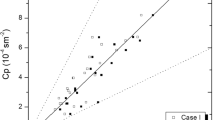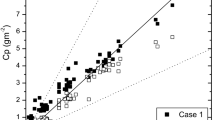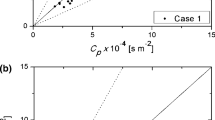Abstract
In this work, two analytical solutions for the 3D steady-state fractional advection–diffusion equation are obtained in order to study the dispersion of air pollutants. The first solution was obtained considering Caputo's derivative, and the other considered a conformable derivative. The Laplace decomposition method (LDM), which generates a fast convergence series solution, was used to obtain the solutions. The solution generated from the Caputo derivative (nonlocal derivative) is represented by the Mittag-Leffler function, which is intrinsic to fractional derivatives, and the solution obtained using the conformable derivative (local derivative) generates an exponential function. The solutions were only identical when they were of integer order (\(\alpha\) = 1). In addition, sensitivity analyses were performed on two explicit parameters obtained in the solutions: fractional parameter \(\alpha\), which controls the order of the fractional derivative, and parameter \(\varphi\), responsible for maintaining the correct dimensionality of the equations. When Caputo and conformable solutions utilized data from the traditional Copenhagen experiment with \(\varphi = 1\) m and \(\alpha\) = 0.98, the values of statistical indexes NMSE = 0.10, COR = 0.90, and FAT2 = 0.91 were shown in both with only small differences in FB and FS, and these results are better than some of the more complex integer-order equation models already existing in the literature. In practical terms, using experimental data moderately convective, it is clear that the models did not show statistically significant differences in the concentrations of pollutants simulated at ground level under conditions of low fractionality, even when considering the dimensional parameter ranging from unity to the smallest scale of atmospheric turbulence (\(\varphi \simeq 10^{ - 3}\) m, Kolmogorov length scale). However, when fractionality increased, the microscale dimensional parameter became more effective, and the results quickly deteriorated.



Similar content being viewed by others
References
Abdelhakim, A. A. (2019). The flaw in the conformable calculus: It is conformable because it is not fractional. Fractional Calculus and Applied Analysis, 22(2), 242–254.
Abdelhakim, A. A., & Machado, J. A. T. (2019). A critical analysis of the conformable derivative. Nonlinear Dynamics, 95, 3063–3073.
Abel, N.H., 1823. Oplosning af et par opgaver ved hjelp af bestemte integraler. Magazin for Naturvidenskaberne, Aargang I, Bind 2, Christiania, 1823. (Translation to French: N.H. Abel, Solution de quesques probl`emes `a l’aide d’int´egrales d´efinies. In: “OEuvres compl`etes de Niels Henrik Abel. Nouvelle edition”, Edited by L. Sylow and S. Lie, Grondahl & Son, Christiania, 1881, Chapter II, pp. 11–27).
Acioli, P. S., Xavier, F. A., & Moreira, D. M. (2019). Mathematical model using fractional derivatives applied to the dispersion of pollutants in the planetary boundary layer. Boundary-Layer Meteorology, 170(2), 285–304.
Adomian, G. (1991). A review of the decomposition method and some recent results for nonlinear equations. Computers and Mathematics with Applications, 21(5), 101–127.
Adomian, G. (1994). Solving frontier problems of physics: The decomposition method (p. 1). Fundamental Theories of Physics, Kluwer Academic Publishers Group, Dordrecht.
Albani, R. A. S., Duda, F. P., & Pimentel, L. C. G. (2015). On the modeling of atmospheric pollutant dispersion during a diurnal cycle: a finite element study. Atmospheric Environment, 118, 19–27.
Anderson, D. R., Camrud, E., & Ulness, D. J. (2019). On the nature of the conformable derivative and its apllications to physics. Journal of Fractional Calculus and Applications, 10(2), 92–135.
Assessment of the unified analytical solution of the steady-state atmospheric diffusion equation for stable conditions. Proceedings of the Royal Society A: Mathematical, Physical and Engineering Sciences 470(2167), 20140021.
Bueler, E., Lingle, C., Kallen-Brown, J., Covey, D., & Bowman, L. (2005). Exact solutions and verification of numerical models for isothermal ice sheets. Journal of Glaciology, 51(173), 291–306.
Butera, S., & Paola, M. (2014). A physically based connection between fractional calculus and fractal geometry. Annals of Physics, 350, 146–158.
Caputo, M. (1967). Linear Models of Dissipation whose Q is almost Frequency Independent- II. Geophysical Journal International, 13(5), 529–539.
Chung, W. (2015). Fractional Newton mechanics with conformable fractional derivative. Journal of Computational and Applied Mathematics, 290, 150–158.
Colin, C., Massion, V., Paci, A., 2017. Adaptation of the meteorological model Meso-NH to laboratory experiments: implementations and validation. Geoscientific Model Development Discussions, 1–32.
Costa, C. P., Vilhena, M. T., Moreira, D. M., & Tirabassi, T. (2006). Semi-analytical solution of the steady three-dimensional advection-diffusion equation in the planetary boundary layer. Atmospheric Environment, 40(29), 5659–5669.
Cotta, R.M., 1993. Integral transforms in computational heat and fluid flow. CRC Press, 352pp.
Debnath, L. (2003). Recent applications of fractional calculus to science and engineering. International Journal of Mathematics and Mathematical Sciences, 54, 3413–3442.
Dos Santos, M. A. (2019). Mittag–leffler memory kernel in Lévy flights. Mathematics, 7(9), 766.
Ebaid, A., Masaedeh, B., & El-Zahar, E. (2017). A new fractional model for the falling body problem. Chinese Physics Letters, 34(2), 020201.
Essa, K. S., Etman, S. M., & Embaby, M. (2007). New analytical solution of the dispersion equation. Atmospheric Research, 84(4), 337–344.
Garcia, J. R., Calderon, M. G., Ortiz, J. M., & Baleanu, D. (2013). Motion of a particle in a resisting medium using fractional calculus approach. Proceedings of the Romanian Academy Series A - Mathematics Physics Technical Sciences Information Science, 14, 42–47.
Gomez-Aguilar, J. F., Miranda-Hernandez, M., Lopez-Lopez, M. G., Alavrado-Martinez, V. M., & Baleanu, D. (2016). Modeling and simulation of the fractional space-time diffusion equation. Communications in Nonlinear Science and Numerical Simulation, 30, 115–127.
Gorenflo, R., & Mainardi, F. (2009). Some recent advances in theory and simulation of fractional diffusion processes. Journal of Computational and Applied Mathematics, 229(2), 400–415.
Goulart, A. G. O., Lazo, M. J., Suarez, J. M. J., & Moreira, D. M. (2017). Fractional derivative models for atmospheric dispersion of pollutants. Physica a: Statistical Mechanics and Its Applications, 477, 9–19.
Gryning, S.E. and Lyck, E., 2002. The Copenhagen tracer experiments: Reporting of measurements. Risø-R-1054, 74pp.
Gryning, S. E., Holtslag, A. A. M., Irwin, J. S., & Sivertsen, B. (1987). Applied dispersion modelling based on meteorological scaling parameters. Atmospheric Environment, 21(1), 79–89.
Gryning, S. E., & Lyck, E. (1984). Atmospheric dispersion from elevated sources in an urban area: Comparison between tracer experiments and model calculations. Journal of Climate and Applied Meteorology, 23(4), 651–660.
Guerrero, J. P., Pimentel, L. C. G., Oliveira-Júnior, J. F., Heilbron Filho, P. F. L., & Ulke, A. G. (2012). A unified analytical solution of the steady-state atmospheric diffusion equation. Atmospheric Environment, 55, 201–212.
He, J. (2018). Fractal calculus and its geometrical explanation. Results in Physics, 10, 272–276.
Khalil, R., Al Horani, M., Yousef, A., & Sababheh, M. (2014). A new definition of fractional derivative. Journal of Computational and Applied Mathematics, 264, 65–70.
Khuri, S. A. (2001). A Laplace decomposition algorithm applied to class of nonlinear differential equations. J. Math. Appl., 1, 141–155.
Meerschaert, M. M., & Tadjeran, C. (2004). Finite difference approximations for fractional advection–dispersion flow equations. Journal of Computational and Applied Mathematics, 172(1), 65–77.
Moreira, D.M., and Vilhena, M.T., 2009. Air pollution and turbulence: modeling and applications. CRC Press, 354pp.
Moreira, D. M., Moraes, A. C., Goulart, A. G., & Albuquerque, T. T. (2014). A contribution to solve the atmospheric diffusion equation with eddy diffusivity depending on source distance. Atmospheric Environment, 83, 254–259.
Moreira, D., & Moret, M. (2018). A new direction in the atmospheric pollutant dispersion inside the planetary boundary layer. Journal of Applied Meteorology and Climatology, 57(1), 185–192.
Moreira, D. M., & Santos, C. A. G. (2019). New approach to handle gas-particle transformation in air pollution modelling using fractional derivatives. Atmospheric Pollution Research, 10(5), 1577–1587.
Moreira, D. M., Tirabassi, T., & Carvalho, J. C. (2005a). Plume dispersion simulation in low wind conditions in stable and convective boundary layers. Atmospheric Environment, 39(20), 3643–3650.
Moreira, D. M., Vilhena, M. T., Buske, D., & Tirabassi, T. (2009). The state-of-art of the GILTT method to simulate pollutant dispersion in the atmosphere. Atmospheric Research, 92(1), 1–17.
Moreira, D. M., Vilhena, M. T., Tirabassi, T., Buske, D., & Cotta, R. (2005b). Near-source atmospheric pollutant dispersion using the new GILTT method. Atmospheric Environment, 39(34), 6289–6294.
Moreira, D. M., Xavier, P., Palmeira, A., & Nascimento, E. G. S. (2019). New approach to solving the atmospheric pollutant dispersion equation using fractional derivatives. International Journal of Heat and Mass Transfer, 144, 118667.
Muñoz-Ruiz, M.L., Parés, C., Russo, G., 2021. Recent advances in numerical methods for hyperbolic PDE systems. Springer, 269pp.
Oldham, K. B., & Spanier, J. (1974). The Fractional Calculus (p. 234). Academic Press.
Ozarslan, R., Ercan, A., & Bas, E. (2019). Novel fractional models compatible with real world problems. Fractal and Fractional, 3(2), 2504–3110.
Palmeira, A., Xavier, P., & Moreira, D. M. (2019). Simulation of atmospheric pollutant dispersion considering a bi-flux process and fractional derivative. Atmospheric Pollution Research, 11, 57–66.
Pasquill, F., & Smith, F. B. (1983). Atmospheric Diffusion. Wiley.
Pimentel, L.C.G., Pérez Guerrero, J.S., Ulke, A.G., Duda, F.P., Heilbron Filho, P.F.L., 2014.
Podlubny, I., 1999. Fractional differential equations. Academic Press, 340pp.
Podlubny, I., Magin, R. L., & Trymorush, I. (2017). Niels Henrik Abel and the birth of fractional calculus. Fractional Calculus and Applied Analysis, 20(5), 1068–1075.
Prates, J. H. S., & Moreira, D. M. (2020a). Fractional derivatives in geophysical modelling: Approaches using the modified Adomian decomposition method. Pure and Applied Geophysics, 177, 4309–4323.
Prates, J. H. S., & Moreira, D. M. (2020b). Um sentido físico para modelagem fracionária: O caso do amortecimento das ondas eletromagnéticas. Revista Brasileira De Ensino De Física, 42, e20200363.
Rosales, J. J., Filoteo, J. D., & González, A. (2018). A comparative analysis of the RC circuit with local and non-local fractional derivatives. Revista Mexicana De Física, 64(6), 647–654.
Ross, B., 1974. Fractional calculus and its applications. Proceedings of the International Conference, New Haven, June, Springer Verlag, New York, 386pp.
Schumer, R., Meerschaert, M.M., Baeumer, B., 2009. Fractional advection‐dispersion equations for modeling transport at the Earth surface. Journal of Geophysical Research: Earth Surface 114(4), F00A07.
Seinfeld, J. H. (1986). Atmospheric Chemistry and Physics of Air Pollution. Wiley.
Sharan, M., & Modani, M. (2006). A two-dimensional analytical model for the dispersion of air-pollutants in the atmosphere with a capping inversion. Atmospheric Environment, 40(19), 3479–3489.
Silva, F. S., Moreira, D. M., & Gonçalves, M. A. M. S. (2018). Conformable Laplace transform of fractional differential equations. AXIOMS, 7(3), 55.
Tarasov, V. E. (2018). No nonlocality. No fractional ferivative. Communications in Nonlinear Science and Numerical Simulation, 62, 157–163.
Tarasov, V. E., & Zaslavsky, G. M. (2006). Dynamics with low-level fractionality. Physica a: Statistical Mechanics and Its Applications, 368, 399–415.
Wazwaz, A.M., 2002. Partial differential equations: methods and applications. Balkema Publisher, 476pp.
West, B. J. (2014). Colloquium: Fractional calculus view of complexity: A tutorial. Reviews of Modern Physics, 86(4), 1169–1186.
Xavier, P. H. F., Nascimento, E. G. S., & Moreira, D. M. (2019). A model using fractional derivatives with vertical eddy diffusivity depending on the source distance applied to the dispersion of atmospheric pollutants. Pure and Applied Geophysics, 176(4), 1797–1806.
Yokuş, A. (2018). Comparison of Caputo and conformable derivatives for time-fractional Korteweg–de Vries equation via the finite difference method. International Journal of Modern Physics B, 32(29), 1850365.
Younas, U., Younis, M., Seadawy, A. R., Rizvi, S. T. R., Althobaiti, S., & Sayed, S. (2021). Diverse exact solutions for modified nonlinear Schrödinger equation with conformable fractional derivative. Results in Physics, 20, 103766.
Zaslavsky, G. M. (1994). Fractional kinetic equation for Hamiltonian chaos. Physica d: Nonlinear Phenomena, 76(1–3), 110–122.
Acknowledgements
This work was supported in part by CNPq and FAPESB.
Author information
Authors and Affiliations
Corresponding author
Additional information
Publisher's Note
Springer Nature remains neutral with regard to jurisdictional claims in published maps and institutional affiliations.
Rights and permissions
Springer Nature or its licensor holds exclusive rights to this article under a publishing agreement with the author(s) or other rightsholder(s); author self-archiving of the accepted manuscript version of this article is solely governed by the terms of such publishing agreement and applicable law.
About this article
Cite this article
de Souza Prates, J.H., da Silva, J.R.D., de Souza, F.M. et al. Three-Dimensional Analytical Solution of the Fractional Atmospheric Pollutant Dispersion Equation Considering Caputo and Conformable Derivatives. Pure Appl. Geophys. 179, 3411–3426 (2022). https://doi.org/10.1007/s00024-022-03114-9
Received:
Revised:
Accepted:
Published:
Issue Date:
DOI: https://doi.org/10.1007/s00024-022-03114-9




